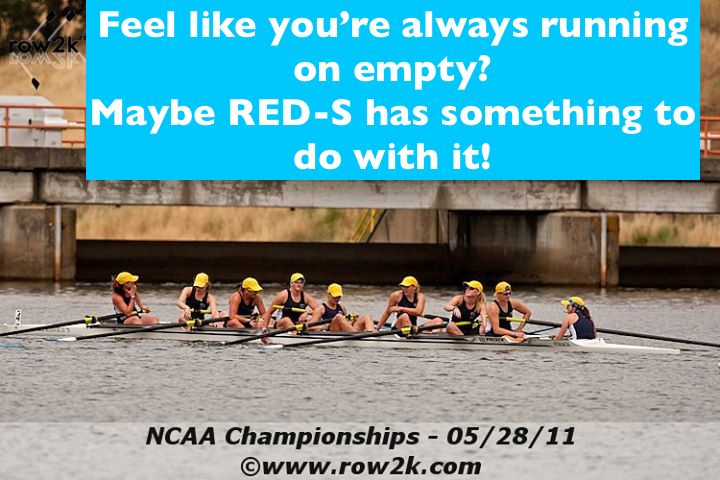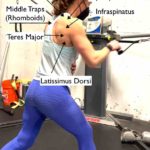Relative Energy Deficiency in Sport (RED-S) is “defined by the International Olympic Committee as a syndrome of health and performance impairments resulting from an energy deficit” (Ackerman 2018). RED-S is something that all rowers and coaches should be aware of to help assess a rower’s tolerance for a training plan and to keep athletes safe and healthy so they can meet their goals! RED-S is an old concept with a new name to better reflect what happens in an athlete when they start to “run on empty”. This is previously referred to as the “Female Athlete Triad” but is now much better understood. RED-S accounts for “impaired physiological functioning caused by a relative energy deficiency and includes but is not limited to, impairments of metabolic rate, menstrual function, bone health, immunity, protein synthesis, and cardiovascular health” (IOC Consensus Statement). RED-S accounts for what happens in both male and female athletes. This post will look into how RED-S might present in rowers both in terms of technique/biomechanics and as overall endurance athletes.
Why do Rowers need to be aware of RED-S?
Endurance athletes, athletes with weight limitations, and power athletes are more often reported as being at risk for developing energy deficiency. Rowers are all of these! We demand many kilometers, hours, and overall a high volume of cardiovascular and metabolic work on our bodies as part of training AND we demand that our bodies produce high levels of power for peak performance (a starting sequence or sprint or a power 10). When you demand a lot of your body, your body demands a lot of your resources and if you have a hard time maintaining the balance between the supply and demand, your body will start to show signs of energy deficiency and go into survival mode. Relative energy deficiency in sport (RED-S) is assessed by looking at energy availability, this is primarily the balance between workload and diet and how your body systems start to change due to significant time spent in energy deficiency or low energy availability (LEA). Within the research energy availability is assessed with this formula:
Energy Availibility= Energy Intake (kcal)- Exercise Energy Expenditure (kcal)/Fat Free Mass (kg)
Energy Availability– “Amount of dietary energy remaining for normal physiological functioning after exercise” (Loucks, 2007)
Fat Free Mass– Reflects the body’s most metabolically active tissues
(Mountjoy, Margo, et al. 2018)
RED-S is more often from chronic or longer-term continuous over demand on your system. The major symtoms don’t appear just because you had one or two harder practices and didn’t refuel properly. It’s from multiple days of piling on the demand without replenishing your stores that essentially starts to dig a hole in your energy reserves. You can have Low Energy Availability (LEA) after a hard workout or between practices but there’s a threshold within each individual rower/athlete that develops into the symptoms associated with RED-S, when your body starts to really “notice”. Studies completed with a goal of seeing how body systems are affected by LEA used an average of 4 days of energy-deficient diet (both with and without exercise) to see how the body responds. Four days was generally long enough for many systems to start to make changes, shifting towards survival mode. This makes you think twice about the effect of just “getting in the workout” when you’re sick or not able to eat enough to support the work, you could be doing more harm to your rowing performance than good during a time period where you cannot keep your energy in and out in balance.
Having solid recovery tactics of proper diet, sleep habits, and listening to your body are good ways to avoid this, with proper diet being the main focus of energy availability. This also speaks to a challenging part of rowing culture, it’s difficult to admit to a coach or teammate that something doesn’t feel right, that you’re “tired” or just don’t feel well and aren’t sure why. It’s difficult to have the confidence that you won’t lose your seat in a boat if you admit to something being wrong. This is a shift that rowing needs to see in our culture, coaches need to create an environment where athletes share how they’re tolerating training and how they’re feeling as individuals even when you’re training in 8+s. This goes right along with the idea that you should never row in pain, rowing when you don’t feel “right” without seeking a solution does you nor your teammates any good in the long run! I hope you can use the information here as a coach and a rower to help start a conversation on how to keep your team healthy while training towards your goals!
Female Athlete Triad versus RED-S
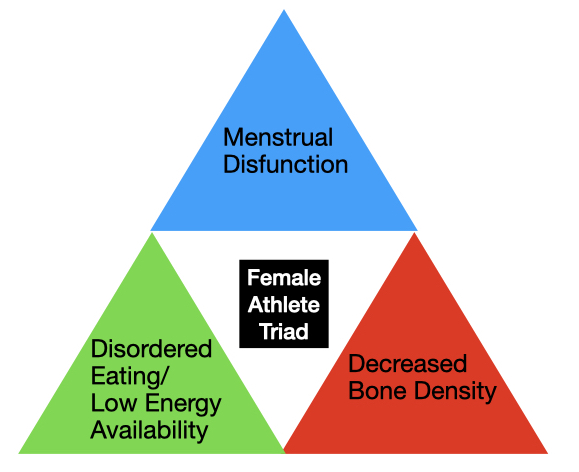
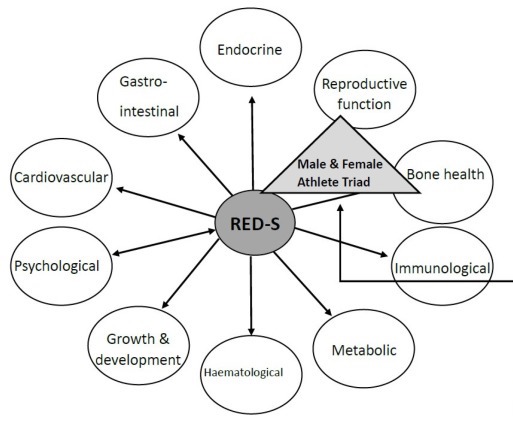
Published online 2020 Mar 20. doi: 10.3390/nu12030835
There is an overlap of course but as you can easily see, RED-S takes into account the 10 body systems that can be affected when an athlete has low energy availability AND it accounts for the fact that men and women are both susceptible to it! The RED-S diagram varies from the thought behind the female athlete triad where low energy is a piece to the puzzle where RED-S puts low energy at the center showing it has a potential link to every other system and that it can affect every other system. There are a lot of variables that can change in someone’s health or overall ability to perform because of an energy deficit, you might be affected in some areas but not others, everyone is different. You shouldn’t feel like you’re entering the 3rd 500 every time you start a workout, you should feel like you have fuel in the tank, that you have power in your leg drive and that you can maintain your posture for a normal amount of practice. If you start to feel like you just want to fall over all the time, stop, speak up, take a break, and look at your energy balance!!!


What is the cause of RED-S?
The math of the answer is simple, you end up in energy deficit from not eating enough to make up for the calories you burn both just by existing in a day AND from your workouts. The real answer is more complicated in that inadequate calorie consumption can occur unintentionally by being unaware of your calorie in: calorie out demands whether due to a training load shift and not adequate food consummation shift, you might have absorption issues you’re unaware of so what you are eating isn’t doing as much for you body as it should. Inadequate calorie intake can also be intentional and be a true eating disorder, which is more common than not. Think of yourself or a teammate that decides they are not going to enjoy x-food or you know they’re restricting with intent of a change in physique or in a thought of how to improve their performance. The trick here is that even if being x number of pounds lighter might help performance or if you’re racing as a lightweight rower and loosing weight is required to be able to race, there are safe ways to get there that don’t compromise your other body systems along the way. One f the best tools in your tool box here is to work with a sports dietitian. Dietitians are massively knowledgable about your metabolisms, demands of being an athlete and how your many body systems interact and what they need from your food to stay supported. Finding a dietitian as a coach that you can have come talk to your team or you can connect athletes with is game changing.
How do RED-S symptoms tie into rowing?
Here are some rowing specific factors to keep in mind:
- Making Weight for Lightweight Rowers (the need to cut calories while having a high energy demand at practice)
- The demand for being strong and lean for heavyweight/open weight rowers
- The difficulty in stopping when you feel like you are over drawn or training is too much
- Being afraid to admit to coaches and teammates when you’re exhausted or becoming injured
- High demand for energy use (calories burned) with inadequate energy intake (calories consumed)
- Changes in training volume without changes in nutrition
- Food Insecurity: financial resources, inadequate availability
Para-Rowers- There is no specific research studying para-rowers specifically but all endurance sport athletes are at higher risk for RED-S to becoming an issue within training. The more challenging aspect for the energy in-out equation within para rowing is that depending on what qualifies a rower as a para participant, the calorie burn rate will be different. Knowing that there are varying baseline caloric or nutrient demands for para-athletes is something to note, the baseline calories (burned without exercise) have not been studied enough for athletes with SCI or amputation or TBI as some examples. No matter the athlete, knowing the signs and symptoms of LEA and RED-S can help avoid serious deficit and injury. Having knowledge of RED-S symptoms is a huge training tool, know when things are off and work to stay in balance or seek help to do so!
How does RED-S present? What do I look out for?
There are 10 physiological systems effected that create 10 performance-related effects from LEA that can present in many different combinations indicating the presence of RED-S(Elliot-Sale et al 2018, Ackerman 2018). Here’s a brief overview of how your body is affected so you know what to watch for in your rowers or yourself to help avoid RED-S related injury or changes and fuel successful performance and training!
What are the performance symptoms?
As studies continue to dive deeper into RED-S we can learn how athletes and coaches can prevent energy deficit that can lead to injury, to irreversible damage to an athlete’s body, and to interrupting training/impacting performance. There is a better understanding of symptoms and what is actually happening to your body when you dig yourself into a hole, so what do you look for?
At this point studies report a range of LEA from 22%-58% of athletes studied (Logue, Danielle M., et al 2020). Most studies at this point have focused on females but there is evidence that LEA affects males and needs more research. Initial studies focused on establishing a clinical threshold for calorie deficit that causes changes in body systems (here’s one on the endocrine changes) linked to RED-S. These studies used both athletes and non-athletes and studied a wide variety of markers that link to the symptoms related to the 10 systems deemed potentially affected by LEA. The most easily tracked and manipulated factor is calorie intake versus output. In both active and non-active people studies have shown blood markers thought to be associated with leading to RED-S.
These studies typically manipulated calories consumed to induce short term LEA (over a 4 day period for example) to see what happens to various blood markers. The threshold used most often eating <30kcal/kg FFM/day, studies admit that truly determining the calories in/out in a “free-living athlete” (Logue, Danielle M., et al 2020) makes defining a threshold for LEA difficult. The next phase was to try and see how athletes might report symptoms of Low Energy Availability.
What are the performance changes you should be aware of?
- Decreased endurance
- Decreased strength
- Depression
- Increased injury risk or frequency
- Decreased training response
- Impaired judgment
- Decreased coordination
- Decreased concentration
- Irritability
- Decreased glycogen scores
What might change in my rowing performance if I am functioning in LEA or developing RED-S symptoms?
Potential Warning Signs:
- Wake up tired
- Decreased power in leg drive
- Difficulty staying connected through the stroke
- Decreased posture earlier in practice (decreased endurance)
- Change in ability to make technique changes (poor coordination)
- Decreased strength in the weight room
- Increasing injury/pain (shoulder, low back, ribs, knees…)
- Increased bruising
- Change in mood
- Change in the ability to concentrate
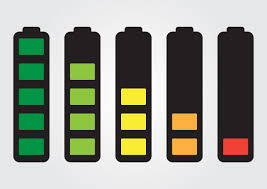
Drawing from personal experience:
My junior year of college, I remember having incredible difficulty keeping a fast leg drive, I felt exhausted, I would get dizzy, I would taste metal during hard pieces and I remember always feeling empty during races like I didn’t have that extra level you needed. These images are from Head of the Fish my junior fall, the left photo is during the warm-up, I remember getting in the boat and thinking “just follow her butt” of my pair partner, and that’s all I could focus on to try and keep moving. The right photo is somewhere close to the finish line, notice how I have lost my posture (3 seat), my shoulder lunging forward and my back rounding I was tired, not because I hadn’t put in the “work” but because I depleted my iron stores. I found out soon after the fall season that I was very low on iron, it’s no wonder my body didn’t want to function, it didn’t have enough oxygen to fuel my work! Looking back, unsurprisingly, I had my first rib “issue” Spring 2010, so many signs of having low energy availability and how RED-S affects multiple body systems. Hindsight is 20:20 of course, but hopefully if you feel this way you’ll get some blood work done sooner than later and see what diet changes you can make!


How LEA/RED-S Affects Your Body Systems:
There are 10 physiological systems that we will dive further into. The purpose of learning more here is so that you might recognize when something isn’t quite right and go seek some further investigation. Asking your Primary Care, sports dietitian or endocrinologist if they understand RED-S is a good way to help determine if they are going to understand how to best help you figure out what’s going on.
- Endocrine System (hormones)
- Metabolic System (metabolic rate)
- Gastrointestinal System (digestion)
- Skeletal System (bones)
- Cardiovascular system (heart)
- Reproductive System (libido, fertility)
- Psychological System (mental health)
- Growth and Development (not on expected growth curves)
- Hematological System (blood markers)
- Immunological (how often are you sick)
Endocrine System- this is your hormones! Your hormones play a role in most of the other systems discussed below. Hormones regulate your metabolism (triiodothyronine (T3)), mood (cortisol), bone health, reproductive system (luteinizing hormone, estrogen, testosterone, progesterone), Gastrointestinal (glucose/insulin) (Logue, Danielle M., et al 2020).
Metabolic System: Your body goes into “survival mode” when there is not enough energy available to maintain all necessary functions. A reduced resting metabolic rate is often seen in athletes who loose their periods (amenorrheic) compared to those who have regular cycles (eumenorrheic) (Elliott-Sale et al 2018). A reduced resting metabolic rate is seen in both male and female endurance athletes (rowers) when the energy intake is less than the energy expended in exercise. Your body stops/slows or reroutes from fat accumulation, growth, and development when there is not enough energy available and prioritizes the necessary processes for survival(Elliott-Sale 2018). For our rowers who are new moms or moms to be: your body prioritizes energy to an active pregnancy or lactation production, you are more at risk of LEA and RED-S if you are in energy deficit during these times!
LEA lowers your resting metabolic rate (RMR) both in men and women. Your body starts to conserve your reserves and make them last as long as possible. This doesn’t help you if you’re trying to lose weight because your baseline calories burned in a day decreases in effort for you body to conserve energy needed to survive and your ability to recover well between workouts becomes very difficult to impossible. This is also when increased injury rates or feeling like you can’t shake soreness that doesn’t usually last after a hard piece day or lift. This has huge implications for lightweight rowers, especially when you are needed to loose weight before competing. If you are in such an overall energy deficit that your resting metabolic rate slows, the amount of calories burned to do your basic body functions slows down in a way to protect your brain, heart and organs, you will have a hard time continuing to loose weight as needed for race day. And most likely. you will start experiencing symptoms related to the other physiologic systems that RED-S affects in your body.
**A study that took male and female elite rowers and upped their training intensity or workload while keeping energy intake.the same over 4 week period all showed significant decreases in RMR!*** (Mountjoy M et al. 2018)
BMI- The lower the BMI needed for a sport (lightweights > open weights) the higher the risk is for being in a state of LEA and developing RED-S related physiological changes. However as found in a study I reviewed for Science of Rowing in the October Issue of 2022, both open-weight and lightweight collegiate females have relatively the same risk for wanting to be lean, limiting food intake and having irregular menstrual cycles. You might not be the right body type to be a lightweight but this doesn’t exempt you from needing to make sure you’re fueling for all the work you’re asking your system to do.
This also doesn’t mean never be a lightweight rower, this means that if you are competing in lightweight categories, you have to be just that much more careful and more vigilant to keep your energy supply in check! Your energy in and out needs to be calculated/recorded in order to avoid the consequences of RED-S/LEA on your body overall. There are safe ways to decrease weight leading into competition, working with a sports dietitian is a great way to make sure you do this for your current and long term health.
Gastro Intestinal System (GI system): If a GI system is affected by LEA you might see, constipation, altered sphincter function (could cause difficulty “holding it” or could cause increased reflux), you could have symptoms like IBS or increased motility through your intestines. Stool leakage and constipation are both more common for someone who has LEA. (Mountjoy, Margo, et al. 2018)
Bones: I discussed the effects of RED-S in my Bone Health post (check it out). The summary is, you end up in RED-s and your body will pull calcium out of your bones to help run your other systems. Calcium is used for muscle firing as well as lots of other body processes, if you don’t have enough in your bloodstream because you’re in an energy deficient state, your bones can suffer. Pulling calcium from your bones decreases your bone mineral density and puts you more at risk for osteopenia, osteoporosis, or stress reactions.
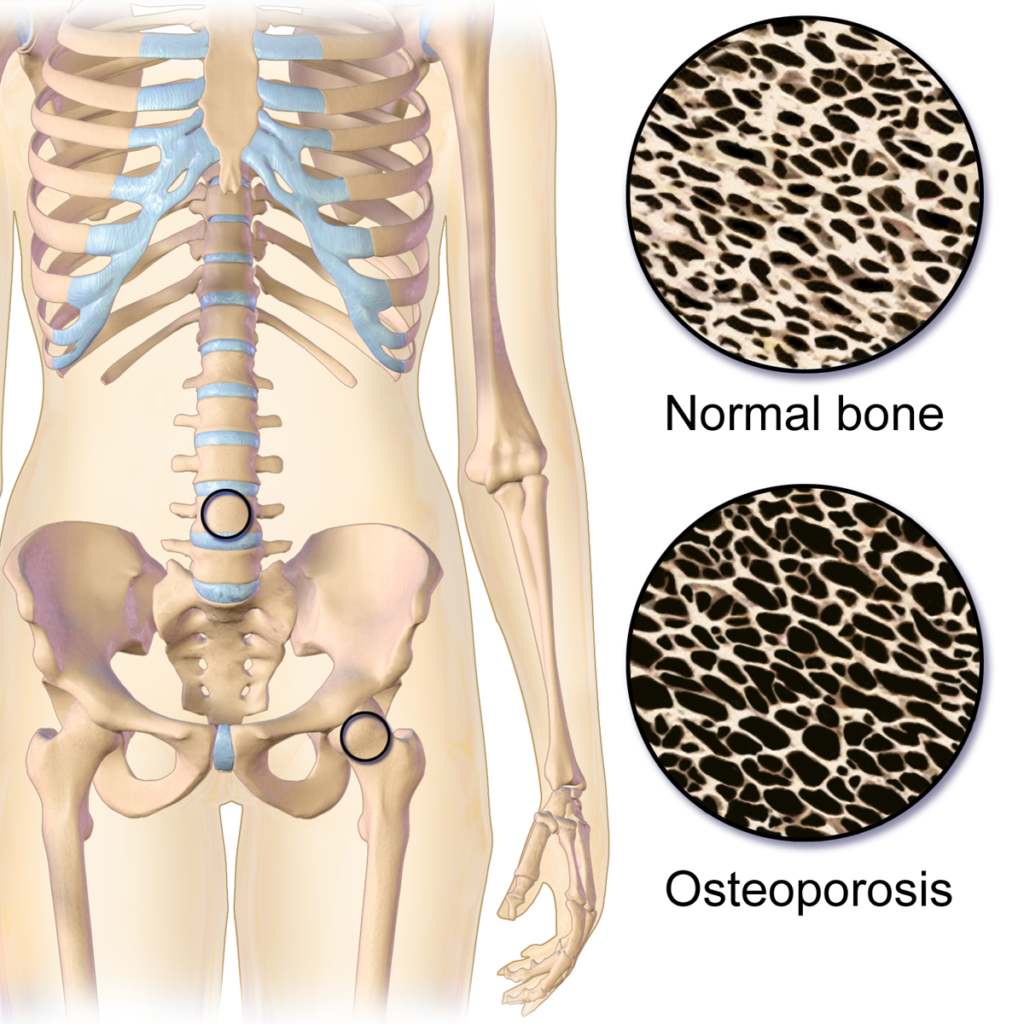
Immune System: If you find yourself getting sick more often than usual (not just because you’re finally no wearing a mask), this could be a sign of overdrawing your energy stores. When your body is drained of its nutrients and energy stores, you become more susceptible to illness. It has been reported that athletes miss training for >22 days due to illness when it relates to low energy availability! (Logue, Danielle M., et al 2020). The illnesses most linked to LEA include respiratory, GI tract, body aches, and head-related symptoms (Mountjoy, Margo, et al. 2018).
Hematologic: Your blood health can tell you quite a lot about whats going on in your body. Low iron and ferritin levels are strongly associated with LEA. This directly correlates to energy deficiency since you need iron to carry oxygen to your body and especially exercising muscles to help them function. Lower iron stores mean you have a lower threshold for work or faster fatigue. You also might see more bruises, changes in bone metabolism or changes in the reproductive system. (Mountjoy, Margo, et al. 2018)
Psychological: Some psychological conditions can be a driving cause of LEA. Athletes with the “drive for thinness” are at higher risk for LEA (Mountjoy, Margo, et al. 2018). Studies with male bodybuilders show that the diet restrictions involved in training can require EA to be between 20-25 kcal/kg FFM/day (remember studies induce LEA with < 30kcal/kg FFM/day). These diet restrictions were shown to decrease muscle mass and decrease strength(Mountjoy, Margo, et al. 2018). This is a caution to lightweight rowers, in particular, the need to restrict diet too drastically to make weight will affect your performance!!
Athletes with low EA often report increased rates of depression, irritability, decreased concentration, and impaired judgment. (Ackerman 2019). These symptoms are very interwoven with the other body systems affected by LEA. Most importantly, if you or a teammate seem to be experiencing psychological changes, it’s worth speaking up! If you’re a physical therapist or athletic trainer and an athlete reports these feelings to you, don’t write it off as a mental health problem you’re not qualified to help with, it could be an energy in/energy out problem. Use your gut, many athletes benefit from having a mental health specialist regardless to help with training but, don’t be scared to dig deeper to alert the rower to the possibility of LEA. Rowers, talk to your primary care to get some blood work, talk to a mental health specialist (there are lots of sports psychologists out there who should be able to help you tease out if some of what you’re feeling is related to LEA).
Cardiovascular: Lower blood pressure and lower heart rates, too low to adequately respond to position changes, causing dizziness or orthostatic conditions. Other conditions noted include early plaque build up in arteries, high cholesterol and in severe cases where anorexia nervosa is involved in creating LEA issues with heart valves, the amount of blood your heart can pump or irregular heart rhythms can happen. (Mountjoy, Margo, et al. 2018).
Growth and Development: Decreased resting metabolic rate, low BMI and low energy availability can contribute to your normal growth and development being slowed or stopped. This means you might change growth curves both in height and weight from your normal trajectory. Let’s face it, unless you’re a coxswain, rowers don’t benefit from being on the shorter side, we all wish and hope for as many inches as possible to be as fast as we can be.
Reproductive System-For males, we’re talking about testosterone and luteinizing hormone being suppressed leading to libido (decreased sex drive). For females, we’re talking about your menstrual cycle being disturbed resulting in amenorrhea or oligomenorrhea (Logue, Danielle M., et al 2020).
“Altering hormonal secretion to minimize reproductive function and maximize survival efficiency may be a well-designed solution to energy deficiency and beneficial for the maintenance of the human species; however, this strategy is not optimal for an athlete’s health and performance.” – Elliott-Sale et al 2018
Losing a period is not the only way you can have disturbance in your menstrual cycle. For athletes not looking to get pregnant, some of these aspects are not something you’re thinking about now, but they are a huge red flag that your body is reallocating resources going into survival mode. You can skip ovulation, have infrequent periods or altered flow and then there’s full amenorrhea, loss of period. Any variation from a regular predicable period should be seen as a sign that something might be off. It’s difficult to compare to “normal” because often active teens don’t establish a regular menstrual cycle anyway, so there is no normal to go off of.
Here’s to hoping times have changed!
I remember when I was a high school and college athlete, my doctors would ask about the regularity of my period, and for the most part, mine was very irregular, in high school, I missed probably 8-9 months of the year. They didn’t seem to be too bothered by it, they generally said my BMI was probably too low to support a period but didn’t suggest I do anything because my mom backed me up that I ate a lot! I just grew tall quickly and was a long-distance runner, so I was athletic but skinny. Crazy now knowing what I have learned, that at the time, it was OK to let an athlete live without a period during prime growing years (bones in particular), without suggesting at some diet changes or volume in workload changes. During cross country and indoor track season, I would skip a lot of months or lose it altogether, during lacrosse (when my energy availability was better) I would get it again. Before I went off to college, my dermatologist suggested the pill (for acne) and then my body responded to the hormone dosing and I got a period all the way through college, but looking back I feel like that was fake. Anemia and rib stress injuries were proof that I wasn’t fueled well enough but the pill made me get my period so I never had ammenoria as a red flag that something was wrong. I wish someone had clued me in on listening to my body and watching for other signs. An idea for female athletes trying to remain healthy while training might be to get your blood levels checked periodically. It’s a good way to make sure you don’t miss something or you catch things early before too many systems are affected.
Regular menstrual cycles can be a sign you’re tolerating training and improving performance!
I have had athletes (rowers and other) I am working with be excited when you don’t have to deal with having a period. They might manipulate their birth control to change when they get it depending on when a big race day is OR they might be glad when it disappears. Please please realize how much your body NEEDS this natural cycle and how much of a sign that other things can also be going wrong the change in your period is. RED-S does a great job of painting this picture compared to the female athlete triad. An altered menstrual cycle really is just the tip of the iceberg! Your body very likely has many other systems affected if you’re losing your period. The rest of the effects of low energy will absolutely affect your performance, make you prone to injury and slower on the erg or the water. So let’s see how RED-s can present, what else beyond a loss of a menstrual cycle you might watch for (especially if you’re a male rower)!
Article Review: Low Energy Surrogates Correlate with Health and Performance Consequences of RED-S
Here’s a summary of a study that was completed at Boston Children’s Division of Sports Medicine as part of the Female Athlete Program to help determine what questions can assist in determining if someone has LEA based on assessing the body systems determined to be involved in an athlete with LEA.
Methods: Survey completed in the waiting room for female athletes between 15-30 years who self-reported 4 or more hours of physical activity per week for at least the last 6 months.
Survey: 133 questions using some established surveys and unique to this study questions for to topics of: general health, illness, injury, sports performance, and RED-S risk factors
Surveys used include: Brief Eating Disorder in Athletes Questionnaire, Eating Disorder Screen for Primary Care
Self-report: Current or past history of an eating disorder or disordered eating
Participants: 1,000 total surveys completed and analyzed; average age 18.92 years old
Body System Specific Questions
Endocrine System/Menstrual Function: amenorrhea (older than 15 year olds), irregular period </= 9/year
Bone Health: >/= 2 bone stress injuries, >/= 1 high-risk bone stress injury (femoral neck, sacrum, pelvis) or reported a DEXA Z-score <-1
Metabolic- asked if the participant had a “known low resting metabolic rate”
Hematological Health- history of anemia, low hemoglobin, iron or ferritin or abnormal bruising
Growth and development: based on self-reported adherence to normal growth curves in childhood
Psychological- impaired functioning reported if the participant reported seeing a mental health professional
Cardiovascular- Preparticipation Examination Fourth Edition: Heart health questions
Gastrointestinal- Low Energy Availability in Females Questionnaire and Faecal Incontinence Questionnaire
Areas not addressed: Study admits these are challenging to quantify via self-report
Decreased glycogen stores
Decreased muscle strength
Results:
Adequate EA- 527 participants. Low EA- 473 participants
BMI- 22.2+/- 3.5. 23.8+/- 3.9

These diagrams show the results of the surveys completed. With the first percentage representing the “Adequate EA” group and the second the “Low EA” group.
The Take-Home Message:
Ever feel like you just can’t respond to what your coach is asking? You can’t concentrate in class or at work as well as usual? You’re just tired and grumpy more than usual? These are signs! Pay attention!
It is way too easy to get sucked into training and have every moment of your day revolve around when your next workout is and just making sure you put in the physical work. It is too easy to brush aside matching your physical efforts with nutrition and recovery. This is where the power of knowing how RED-S can affect your rowing and what rowers and coaches should watch for/be aware of is very impactful!
I have been there, done that with LEA too many times to count, between being a cross country runner, marathoner, rower, and generally someone who loves to move, I have been dealt the consequences of not listening to the warning signs. Again the hope is that you can prevent getting to. the point of affecting your body systems as RED-S outlines for yourself, a teammate or a rower in your program if you’re a coach.
When I continued to train to the point that I stress fractured my ribs, I remember feeling like I could not really “feel” my body for a while leading up to the injury. I was disconnected from my oars, I couldn’t make technique adjustments, I really as just exhausted from the moment I got dressed in the morning.
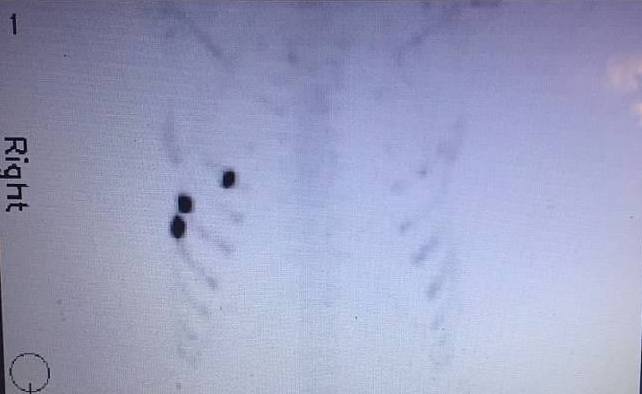
But I was so focused on needing to get my workout in AND it felt like I really couldn’t miss anything because I wasn’t performing well, so I felt like I needed to put in more time. If I had STOPPED to realize what my body was telling me, maybe I wouldn’t have fractured my ribs and been stuck on the bike for 3-4 months with lifting restrictions, maybe I wouldn’t have missed selection regattas. I remember being so irritable with my roommates and not really enjoying being around my friends Head of the Charles weekend that year. I was depressed without realizing it, I was overdrawn and living in an energy deficit, it was not fun!
Current tools used clinically: (Logue, Danielle M., et al 2020)
- Low Energy Availability in Females Questionnaire (LEAF-Q)- looks at disfunction of menstrual and GI systems, injury history and oral contraceptive use
- (Low Energy Availability in Male’s Questionnaire (LEAM-Q) is currently being developed!)
- RED-S Clinical Assessment Tool (RED-S CAT)-
- Diagnostic Criteria of the Triad
- Eating Disorder Examination Questionnaire (EDE-Q)- scores can help see if an athlete adjusts energy intake for output!
- Reproductive biomarkers (estrogen, progesterone for female cycles; testosterone and LH for male libido)
Danielle M. Logue et al in their article in Nutrients, 2020 conclude that LEA is better detected by identifying symptoms and measuring biomarkers associated with RED-S is more effective than using a nutrition diary with exercise logs.
Your body tries to communicate with you, you just have to be willing to listen and make a change!
Articles Referenced
Ackerman, Kathryn E, et al. “Low Energy Availability Surrogates Correlate with Health and Performance Consequences of Relative Energy Deficiency in Sport.” British Journal of Sports Medicine, vol. 53, no. 10, 2018, pp. 628–633., doi:10.1136/bjsports-2017-098958.
Elliott-Sale, Kirsty J., et al. “Endocrine Effects of Relative Energy Deficiency in Sport.” International Journal of Sport Nutrition and Exercise Metabolism, vol. 28, no. 4, 2018, pp. 335–349., doi:10.1123/ijsnem.2018-0127.
Logue, Danielle M., et al. “Low Energy Availability in Athletes 2020: An Updated Narrative Review of Prevalence, Risk, Within-Day Energy Balance, Knowledge, and Impact on Sports Performance.” Nutrients, vol. 12, no. 3, 2020, p. 835., doi:10.3390/nu12030835.
Mountjoy, Margo, et al. “International Olympic Committee (IOC) Consensus Statement on Relative Energy Deficiency in Sport (RED-S): 2018 Update.” International Journal of Sport Nutrition and Exercise Metabolism, vol. 28, no. 4, 2018, pp. 316–331., doi:10.1123/ijsnem.2018-0136.
“Relative Energy Deficiency in Sport (RED-S).” British Journal of Sports Medicine, BMJ Publishing Group Ltd and British Association of Sport and Exercise Medicine, 1 Apr. 2015, bjsm.bmj.com/content/49/7/421.

